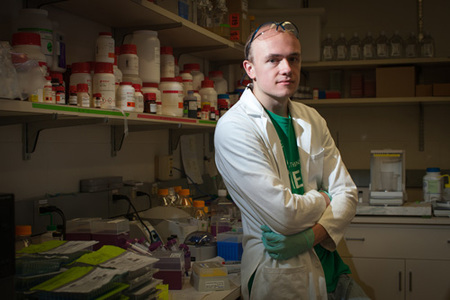
What do you get when you combine cutting-edge research, cultural excursions and surprisingly competitive volleyball matches?
An internship at one of the most highly respected laboratories in the country.
Cold Spring Harbor Laboratory, a biological research institution located on Long Island, enjoys international recognition for its groundbreaking work. Every year, the lab accepts 25 undergraduates from around the world to partake in an intensive, 10-week research experience under the guidance of world-renowned scientists. Students also participate in a number of organized, lab-wide events, including trips to nearby New York City and an annual end-of-the-summer mentor/intern volleyball match. Traditionally, Notre Dame sends at least one student to the program every year. This year, Toby Turney was one of two ND students selected for the internship.
Turney is a junior biochemistry major living in Keenan Hall. On campus, he works in Dr. Tony Serriani’s lab conducting structural studies of sugars using x-ray crystallography and molecular modeling strategies. Speaking about his start in Serriani’s lab, Turney emphasized the importance of taking advantage of connections.
“Serriani was a speaker for one of my seminars sophomore year,” Turney said. “I was really interested in the work he was doing, so I reached out to him. Turns out he was looking for undergraduates to work in his lab, and I’ve been working for him since.”
Turney stumbled upon Cold Spring in a similar manner. He first heard about the program his freshman year from Rebecca Marton, his Introductory Biology lab TA. At the end of his sophomore year, he decided to apply for an internship at Cold Spring and ended up in the lab of Dr. Daryl Pappin. Pappin assigned Turney the complex task of purifying a protein that could have groundbreaking implications for protein characterization techniques.
“I’m really interested in molecular structures,” Turney explained. “I’ve been interested in structural biology since high school, and my work in Dr. Serriani’s lab has fallen along those lines. So I was really excited to get a chance to work in a lab this summer that focused a lot on protein structure.”
Turney’s interest in structural biology, like his research experiences, was something he stumbled upon. During high school, he encountered the work of Dr. David Baker, who created a public video game to generate the computer power necessary to complete his research on protein folding. Using this game, Baker has made a number of revolutionary discoveries, including determining the crystal structure of a protein produced by HIV.
“I loved the idea that simple problem-solving skills could be applied to solve important scientific questions,” Turney said. “I also love the teaching aspect of structural biology. If you have a picture of a molecule it can be surprisingly easy to explain science to someone who isn’t a scientist.”
Along this vein, Turney revealed his plans to attend graduate school after ND and to pursue a career in academia. He stressed the importance of undergraduate opportunities in shaping one’s research interests and future career.
“Be open to doing new things.” Turney advised. “When I first started doing research I was only interested in experimental work. I had no desire to do computational research. Now, thanks to my various undergraduate research experiences, I’ve fallen in love with it.”
